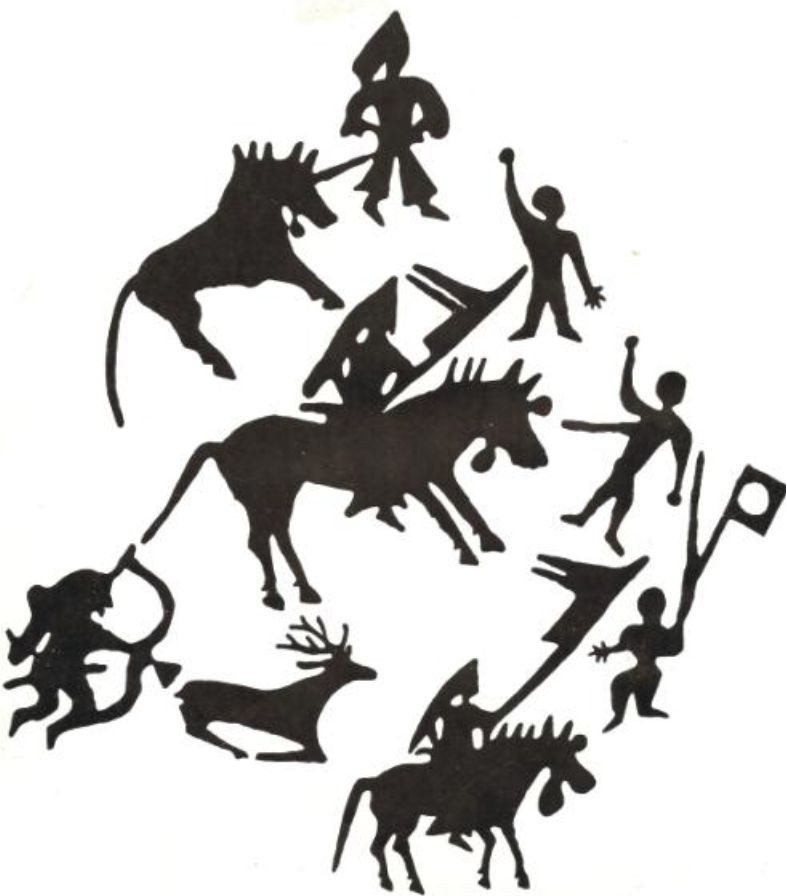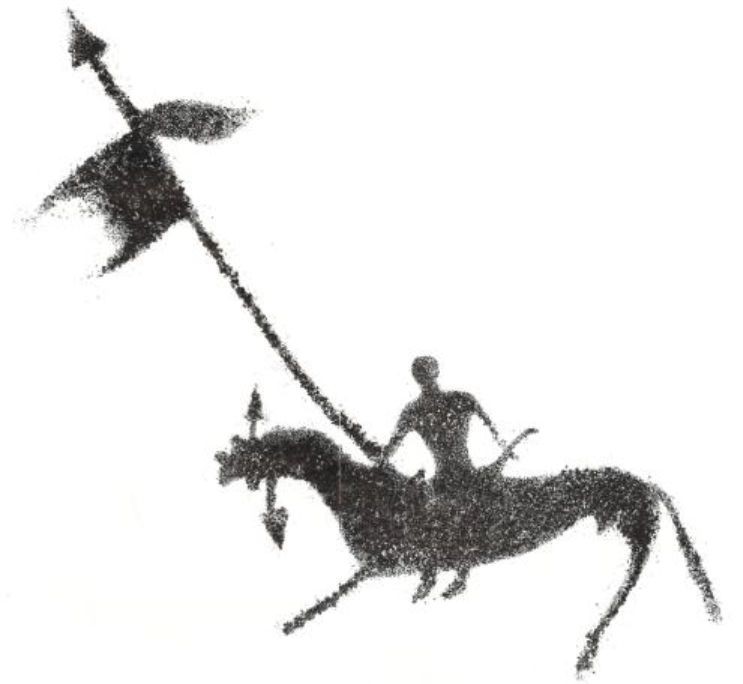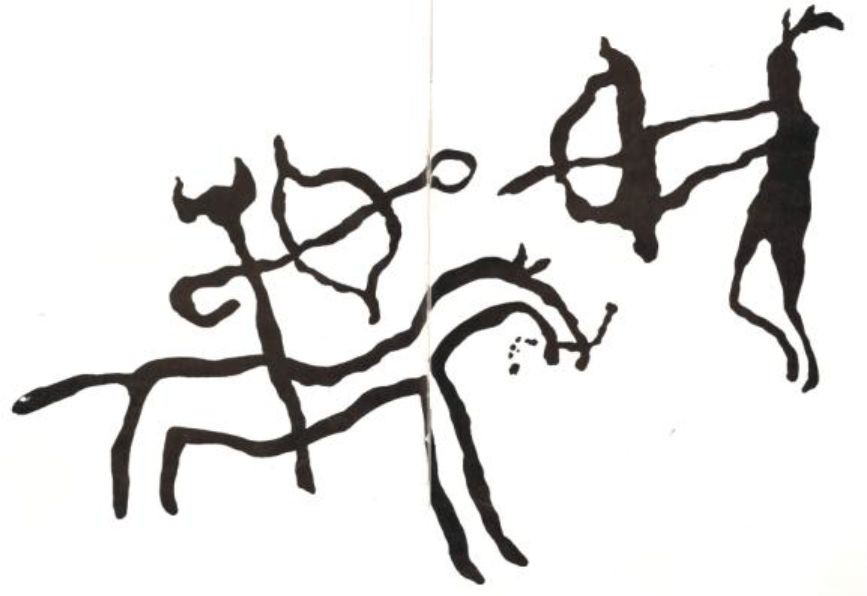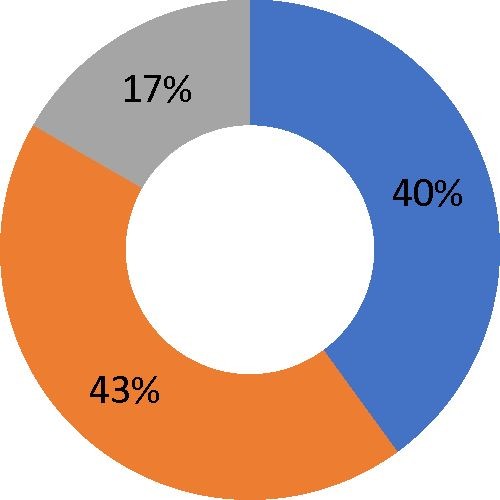Today, the creation of Cultural Studies in Kazakhstan is one of the most important tasks. One of the sources of culture in this field of science is spiritual and material values, the fundamental values of our knowledge. In this regard, the article considers petroglyphs of the ancient Turkic period – monuments of material values of history and culture. The ancient Turkic era is a powerful period of military hegemonic policy. Therefore, the article discusses and presents to the reader images of military scenes of that era in stone relief. The authors of the article, having conducted a scientific analysis of the material values of historical time, set the goal of how to implement it.
Introduction
This article presents a culturological analysis of three petroglyphs with a military motif, built on rocks in Kazakhstan. The authors consider in a special section relief images on a stone surface associated with courage and strangeness, symbolism, spirit, and glory [1; 193, 2; 6].
The purpose of the article is to study the history of Kazakhstan and its cultural expertise [3; 118–121]. It should be noted that the petroglyphs “glory of the ancient Turks”, “flag bearer”, and “war of horsemen and foot archers”, related to the culture of the ancient Turks, have so far been studied only in historical and archeological aspects [4; 63]. Also, the authors point out that the three named petroglyphs were not specifically studied separately.
The relevance of the article lies in the fact that after forming a sovereign country, Kazakhstan is able to look into the depth of its history, comprehend it, and conduct research on it. Any nation needs cultural and philosophical reflection in the process of civilizational development [4; 112]. After all, in the historical fate of the nation, the past and the present, the present and the future are inextricably linked. Intensification of research concerning the history and culture of the Kazakh people in the years after independence is one of the main characteristics of the desire of the national consciousness to know its roots. In the petroglyphic art of Kazakhstan, which has fifteen thousand centuries of history, a special place is occupied by the ancient cultural heritage, historical memory. Subsequently, the main task of the authors is to study the given topic in a scientific direction, including at the cultural level, to attach importance to the basics of the country’s history.
Experimental
The scientific article is based on the cognitive-value method. The authors state in the final part whether this method is effective or ineffective. They emphasize that the cognitive-value method is a search used for cultural analysis. In addition, the article uses historical, archeological subject-detailing techniques [5; 23].
At the same time, the authors of the article note that in the cultural analysis of the petroglyphs “glory of the ancient Turks”, “flag bearer”, and “war of horsemen and foot archers”, their folklore and ethnographic aspect is especially revealed in the national, domestic meaning [4; 156]. In this respect, the article is examined in a culturological context, as a result of which ideological and social sources are revealed.
The article aims to substantiate the material values of cultural studies, to contribute to the theoretical and practical significance. However, the authors point out the absence of the theoretical and practical side of the substantiation of the material values of cultural studies. Therefore, they note that the methods and techniques used to substantiate the material values of cultural studies are perceived as experiment, control and are fixed in the conclusion.
Sources related to the study comprise monuments of material culture. The rock carvings found on the territory of Kazakhstan are derived from petroglyphs belonging to the ancient Turkic culture.
“The glory of the ancient Turks” (Figure 1). Petroglyphs were found in the north-western part of southern Kazakhstan, Mount Kindyktas, and the Trans-Ili Alatau. The mentioned petroglyph is presented as an album with an etching pattern on the page of Medoev A.G. “Engravings on rock” and a scientific reference to it. The author, combining this picture on the stone and the two petroglyphs that we consider, suggests the following scientific thought: “The ancient Turkic petroglyphs reflect the great dream and power of the main figures of the country. Therefore, we can say that the images of the Turkic stone figures of argymaks of noble origin, men with flags in their hands, and religious and mythological images related to Umai reflect the appearance of the Turkic era. Most importantly, in science, images on the stone can be studied as a diplomatic document or a history of politics” [4].

Figure 1. The glory of the ancient Turks
One of the following works of the Turkic period is “Flag bearer” (Figure 2) [4; 26]. Petroglyphs are depicted on the rocks of tanbaly, south-eastern part of Mount Shuili. Petroglyphs are best described in Maksimova, Yermolaeva and Maryashev’s work “On rock carvings”. The body of the horse is long and slender, the neck is flat, the legs are thin, and the front legs are long. The tail is thin and curly. The wings are proportionate. At first glance, it is impossible to understand the basic image of a horse. The rider’s shoulders are broad and curved. The image of a flag in one hand and a sword in the other as if describing the motto.

Figure 2. Flag bearer
The next petroglyph is “The war of horsemen and foot archers” (Figure 3) [4; 32]. Tamgaly is the south-eastern part of Mount Shuili. Mount Anyrakay is located about 170 km northwest of Almaty. An unknown artist, who painted two soldiers with bows, used two different techniques for drawing. The Archer on the horse is executed only on contour lines. The Walking Archer is depicted in the silhouette technique as a spot. The hats of the two soldiers are different. An archer on the horse looks like a soldier with two horns. The head of the second archer is shaped like a helmet. In the same way, the Bow Arrow is different and clearly visible. The head of a mounted archer resembles a round arrow of a foot archer.

Figure 3. The war of horsemen and foot archers
The general features of the above-mentioned petroglyphs were defined as a methodological map. It reflects the concepts of war and battle, courage and spirit. According to historical data, the Turkic peoples are a fundamental indicator of nomadic culture. In particular, it is believed that the beginning of the military era, which is a manifestation of nomadic culture, was formed from the Turkic era.
Analysis
Paintings carved on such shale surfaces or painted in colors of that period are distributed on the territory of Kazakhstan. At the same time, their concentration is known. Particularly, these are the places of concentration of petroglyphs, which have been carefully studied and put into scientific circulation: Akbauyr, Arpauzen, Bayanzhurek, Eschiolmes, Karatau, Koybagar, Maidan, Moynak, Tamgaly, Terekty Aulie, and others, are valuable material that provides accurate information from different periods of the history of Kazakhstan [5; 65]. The petroglyphs of the Turkic military style show that the “The glory of the ancient Turks”, “Flag bearer”, and “The war of horsemen and foot archers” were the spirit of our ancient ancestors. In general, many petroglyphs have been preserved on the territory of Kazakhstan, which give information about the ancient Turks. Alkey Margulan, an outstanding researcher, gives accurate information about this: Petroglyphs are found in the Altai, Tarbagatai, Semirechye, Dzungarian Alatau, Kulzhabasy, Anyrakai, Khantau mountains, rocks in the upper reaches of the Karatau River, and other places. In the Western Turkic Khaganate, in the Valley of the Shu River, on the Kordai rocks, there are large petroglyphs depicting horsemen with Wolf flags armed with long spears. This is because all three of the petroglyphs are dedicated to a military theme, and as researcher Alkey Margulan points out, they describe the strength and courage of the Turks [5; 55]. At the same time, these images in the genre of military prowess form historical material values and define the national needs of the state.
In general, the three petroglyphs are close to the ethnographic direction of science. It is especially evident in the weapons of noble princes and glorious warriors depicted on stone reliefs, in the harnesses of horses and their flags. For example, in the petroglyphs “The glory of the ancient Turks”, “Flag bearer” there are images of warriors holding flags and banners. In particular, the plot of the petroglyph “The glory of the ancient Turks” has a round symbol on the flag of a knight without a hat, except for the flag bearer, who is kneeling with the flags of the princes with pigtails. In the work “History of the Turkic People” by K. Amanzholov and K. Rakhmetov, the flag of the noble princes is called the “flag of the Yellow House”. Given this definition, we interpret the “round” symbol as the symbol of the Dulat tribe, which existed alongside the Usuns. Because the famous orientalists N.Ya. Bichurin and G.Е. Grumm-Grzhimailo, Academician S.Е. Malov and the first Kazakh scientist Sh. Valikhanov wrote that the Usun and Dulat tribes were in one union, ru-tribal alliances. N.Ya. Bichurin and G.Е. Grumm-Grzhimailo explain that “in the union of the Usun tribes, which formed a khanate two centuries before our era, there was also the Dulu tribe ... Then the country inherited by Dalu was called Dalu, Dalug, Dulug”. It is said that this Dulu (later Duglat, Doglat, Dulat) played an important role in the establishment of the first Turkic Khaganate in Turkic history. Academician S.Е. Malov said that in the ancient Turkic inscription on Kultegin’s tomb there were brothers umin kagan and Estemi kagan Dulu. As for the unity of the Usun and Dulat tribes, Sh. Valikhanov wrote in the Kazakh chronicle: “The Great huz consists of four main alliances: Dulat, halayr, Alban, Suan; They all call themselves “Usun” with a common name. The Usuns were once a powerful tribe of these four tribes. In particular, Grumm-Grzhimailo’s scientific statement that “Dulus have a tradition of placing stones on the heads of heroes who died on the way to the campaign and marking the tribes that took part in the campaign” seems to be aimed at this very plot. If we go back to the picture on the stone, we see a fork-shaped “circle” in the hands of a kneeling person. Then the question arises as to whether it is possible to form an alliance of stonedwelling Usuns and Dulats” [6; 178].
Historical and cultural material details based on ethnographic orientation in the following petroglyphs are depictions of the weapons of the warriors. The history of slate paintings on the territory of Kazakhstan connects the era of the ancient Turks with the depiction of weapons of warriors. There is a lot of historical information about it. At the same time, there is the genesis of the origin of the Turkic people, and the Turks are known around the world as “iron producers”. Therefore, the essence of this argument is related to the armed soldiers on this stone.
Certain names of weapons are also found in the petroglyphs we are considering. For example, in the petroglyph “The war of horsemen and foot archers” (Fig. 3), the arrows of the two archers are different from each other. According to petroglyphists, each image on the stone is built to provide “accurate information” apart from the plot. At the same time, there is an opinion that in the petroglyph there is an “irrational” image, that is, the exact construction of the object. For instance, in the petroglyph of the sun-god, the shaman’s hats are placed.
Researcher of the history of weapons of Central Asian nomads Yu.S. Khudyakov and the researcher of the history of Kazakh weapons [7; 48], ethnographer Kaliolla Akhmetzhanov, in their research, developed classifications of weapons [8; 155]. In “The war of horsemen and foot archers”, the arrowhead of the archer in the petroglyph shows that the arrowhead was round and that the ancient warriors had arrowheads. In particular, ethnographer Kaliolla Akhmetzhanov says that “Kazakh arrows have arrows that perform their own function”. In view of this, we conclude that the round triangular arrow in the relief image is “not invested in vain” under the order in which the petroglyphs provide “accurate information” apart from the plot [8; 152].
In the main analysis, we briefly described the three petroglyphs in terms of ethnography. We also found that petroglyphs performed informational and cognitive functions in ancient culture [9; 1–8]. Rock carvings were not the product of human imagination. Therefore, for the researcher, the cognitive content of the petroglyphs comes to the fore in comparison with the art. It is obvious that the “artist-author” who gave birth to the petroglyphs was more deeply interested in the information and content aspects than in its stylistic features and artistic side.
Result
Cultural analysis in science covers a wide range and has many types, such as ideological, civilizational, philosophical, social, socio-ecological, functional, modern, textual, etc. This study demonstrates a “historical-cultural” cultural analysis [10; 110–119, 11; 173–177]. At the same time, “historical-cultural” cultural analysis includes the process of “rethinking”. Our study results cover three specific areas: - Cultural monuments found on the territory of Kazakhstan (including the three petroglyphs we are studying) are the cultural heritage of the state; - Objects of research (petroglyphs) are artifacts of material value of the history of the homeland; - Increase in the level of cognitive knowledge. We have described the basis and course of these three areas, especially in the analysis section, by analyzing the three petroglyphs, which indicates the significance of Kazakhstan’s history.
Increase in the level of cognitive knowledge. The valuable, cherished heritage of mankind from ancient times to the present day is called a “monument”. Now these three cultural monuments, the three petroglyphs we are studying, are the cultural heritage of the country and the people. In epistemology or epistemology, a person performs two main types of cognitive activity, one of which is recognizing the world through the results of cognitive activity of other generations, and finally the material and spiritual culture. Since the independence of the Republic, the process of re-examining the history of the country has intensified. In particular, archeological monuments and historical monuments have been extensively studied and are being studied. Therefore, the level of “historical and cultural” knowledge in the country has increased or is still needed. Given this situation, we are looking for an answer to the question of what is our cultural achievement in the process of “going back to the past”.
We created an experimental questionnaire based on the three petroglyphs we considered. The questions in this survey are as follows: “Can you combine the three petroglyphs and tell us about their content?”; “Have you ever met these petroglyphs in the media or on TV?”. As a result, depending on the level of response of respondents, we selected them into four groups on the first question and three groups on the second question.
Table 1
“Can you combine three petroglyphs and tell us about the content?” the result of the request.
|
1st group A group of people who know the full information |
2nd group A group of people who reported their impressions of petroglyphs only as knowledge |
3rd group A group of people who reported the impact of the picture as average education |
4th group A group of people who responded by perceiving the picture not as knowledge, but with their own thoughts |
|
8 |
6 |
5 |
11 |
According to the responses of respondents interviewed in the survey, as a result, the first group knows full information about the petroglyphs we study, including the history of the ancient Turks (27%). The second group does not know petroglyphs, including Turkic history, but presents their impressions of the painting as knowledge (17%). Those in the third group had never encountered the picture and described the impressions received as secondary education (20%). The fourth group perceives the picture not as an education, but with their thoughts and respondents (36%) (Table 1).
Answers of a number of selected respondents:
The first respondent (Abzal): “Our ancestors were very heroic. Especially the ancient Turks, who were considered descendants of the Saks-Huns, left an indelible mark in history. I had moments when I came across images of such slate surfaces that their fighters saw. For example, in Chingiztau in the Abai district there are rock carvings associated with such a war. Scientists, having investigated this from the photos presented as a general overview, get a spirit. We are proud that we have descendants of yesterday’s Turks”.
The second respondent said (Zhanserik): “I haven’t seen these images. But looking at the photos, I remember the history of Kazakhstan. A history teacher came to us and said that the ancestors of the Kazakhs were national wars. “There is historical information about them, there are heroic paintings painted on stones and walls”.
The third respondent (Ardak): “My impression of the painting is that I see these paintings for the first time. I was particularly impressed by this painting (petroglyphs” The glory of the ancient Turks”). People with flags on their hands came to agree with the opposite people. And the person on his knees, holding a flag with a round symbol on his hand, realized that he was responding to them”.
The fourth respondent (Sania): “I think the picture depicts the moments of heroes fighting”.
According to the second survey, the following results were obtained.
Table 2
“Have you ever met these petroglyphs in the media or on TV?” according to the results of the request.
|
Group 1 Yes, I saw it on national television. |
Group 2 No, I didn’t see it anywhere and didn’t pay attention. |
Group 3 I find it difficult to answer |
|
12 |
13 |
5 |
As today national TV channels broadcast on television a lot of educational programs and documentaries concerning the history of the country and the fact that petroglyphs are visual information, we have put a survey on this side (Table 2).
Based on the results, we have compiled the following percentage chart (Figure 4).
 Yes, I saw it on national television
Yes, I saw it on national television
No, I didn't watch it on national television and didn't care
I find it difficult to answer
Figure 4. “Have you ever met these petroglyphs in the media or on TV?”
As can be seen from the above sociological survey, we conducted tablitsa and diagaramma to activate the trend of “returning to the past” of three petroglyphs with the effect of cultural analysis. We have also chosen three directions that are the result of the article. We have analyzed the increase or non-increase in the level of cognitive knowledge through special tabs and diagnoses. Its main reason was the culturological analysis of three petroglyphs.
Conclusions
Summing up the research article, we made a cultural analysis of archeological monuments, including petroglyphs. As mentioned in the section on results, the process of “rethinking” was analyzed by creating a questionnaire that defines what the slate paintings, which reflect the fighting spirit of the ancient ancestral traditions. In this regard, we provide following conclusions:
- We clarified that the petroglyphs of the ancient Turkic period, as well as the study of other historical artifacts, conduct scientific research to increase the level of historical and cultural values of our country today;
- A review of the process of “returning to the past” of historical and cultural values, which we have studied and other studies similar to our topic, is carried out “traditionally” in science. In particular, the article provides an ethnographic analysis of the material details of the relief images on the stone surface.
In addition, we provide the following solutions:
- To determine the level of cognitive knowledge of the citizens of the country in accordance with the process of feedback, the recognition of the research work of today’s domestic scientists through the media;
- To create a criterion for the size of the value base of the culture of the country today in this feedback process.
- Golden, P.B. (2011). Central Asia in World History. Oxford University Press. Retrieved from https://cyberleninka.ru/article/n/2013-03-006-golden-p-b-tsentralnaya-aziya-vo-vsemirnoy-istorii-golden-p-b-central-asia-in-world- history-oxford-etc-oxford-univ-press-2011-xi-178-pdf.
- Іzteleuova, L.I., Shaikhgaliyev, Ye.A., ekishev K.O. (2016). Turіk qaganatyndagy basqaru zhuiesіnіn erekshelikteri [Features of the management system in the Turkic khaganate]. Scientific E–journal «edu.e-history.kz», 1(05). Retrieved from https://edu.e-history.kz/ru/publications/view/371 [in Kazakh].
- Lamb, M. (2014). Central Asia in World History. Comparative Review of Civilizations. Retrieved from https://scholarsarchive.byu.edu/ccr/vol70/iss70/122.
- Medoev, A.G. (1979). Graviury na skalakh [Engravings on rocks]. Almaty: Zhalyn [in Russian].
- Samashev, Z. (2006). Petroglify Kazakhstana [Petroglyphs of Kazakhstan]. Almaty [in Russian].
- Amanzholov, K.R., Rakhmetov Q. Turki khalyqtarynyn tarikhy: kone dauirden bizdin zamanymyzdyn XIV gasyryna deiingi kezen [History of the Turkic peoples: from ancient times to the XIV century of our time]. Zh. Qairanbaev. (Eds.). Almaty: Bilim [in Kazakh].
- Khudiakov, Yu.S. (1993). Vooruzhenie tsentralno-aziatskikh kochevnikov v epokhu rannego i razvitogo Srednevekovia [The armament of Central Asian nomads in the era of the early and developed Middle Ages]. Almaty: Nauka [in Russian].
- Qaliollaulu, A. (2003). һaq pen oq [Jaws and arrows]. Juldyz – The star, 6, 151-158 [in Kazakh].
- Lyons, M. (2012). New directions in the history of written culture. Digital magazine «Culture and History». P. 425-437. Retrieved from https://doi.org/10.3989/chdj.2012.007
- Moldabekov, h. (2011). Madeni mura masele retіnde: Sipattamalyq erekshelіkterі zhane zertteu ustanymy [Cultural heritage as a problem: Characteristic features and research position]. Qazaq ulttyq universitetinin khabarshysy. Filosofiia, saiasattanu zhane madeniettanu seriiasy — Bulletin of the Kazakh National University. Philosophy, Culture and Political Series, 2(37), 110-119 [in Kazakh].
- Nurzhanov, . (2010). Cһto takoe «cultural studies»? [What is cultural studies]. Vestnik Kazakhskogo natsionalnogo universiteta. Seriia Filosofiia, politologiia i kulturologiia — Bulletin of the Kazakh National University. Philosophy, Culture and Political Series, 1(34), 173–177 [in Russian].